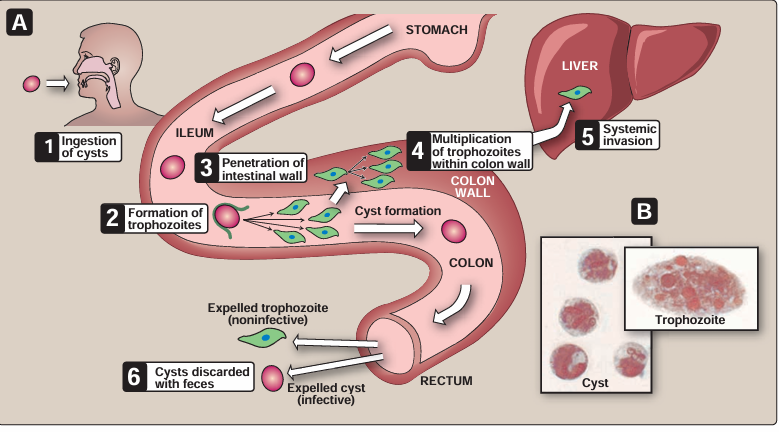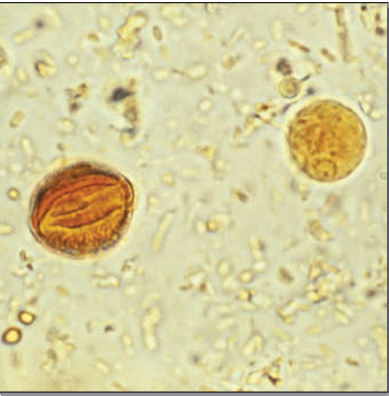


 النبات
النبات
 الحيوان
الحيوان
 الأحياء المجهرية
الأحياء المجهرية
 علم الأمراض
علم الأمراض
 التقانة الإحيائية
التقانة الإحيائية
 التقنية الحيوية المكروبية
التقنية الحيوية المكروبية
 التقنية الحياتية النانوية
التقنية الحياتية النانوية
 علم الأجنة
علم الأجنة
 الأحياء الجزيئي
الأحياء الجزيئي
 علم وظائف الأعضاء
علم وظائف الأعضاء
 الغدد
الغدد
 المضادات الحيوية
المضادات الحيوية|
Read More
Date: 2025-02-25
Date: 2025-01-29
Date: 28-10-2015
|
There are four principal protozoal intestinal parasites: the ameba, Entamoeba histolytica; the flagellate, Giardia lamblia; the sporozoan, Cryptosporidium (several species); and Balantidium coli (the only ciliate protozoan to cause human disease). Each pathogen causes diarrhea, which, although similar, differ in the site of infection, its severity, and secondary consequences.
A. Amebic dysentery (Entamoeba histolytica)
Ingested cysts from contaminated food or water form trophozoites in the small intestine (Figure 1). These pass to the colon, where they feed on intestinal bacteria, and may invade the epithelium, potentially inducing ulceration. The parasite can further spread to the liver and cause abscesses. In the colon, trophozoites form cysts that pass in the feces. Amebic cysts are resistant to chlorine concentrations used in most water treatment facilities. Diagnosis is made by examination of fecal samples for motile trophozoites or cysts (Figure 2). Serologic test kits are useful when microscopic examination is negative. Liver abscesses should be biopsied from the abscess edge where the active amebas accumulate. Mild cases of luminal amebic dysentery are treated with iodoquinol, paromomycin, or diloxanide furoate. More severe cases, including liver infections, are treated with metronidazole (which also has antibacterial activity) in combination with chloroquine and/or diloxamide furoate or emetine. Up to 80% of infections due to E. histolytica are asymptomatic. These asymptomatic cyst-passers are a source of infection to others and may not be detected because they are asymptomatic.

Fig1. A. Life cycle of Entamoeba histolytica. B. Photomicrographs of trophozoite and cyst forms.

Fig2. Entamoeba histolytica cysts.
B. Giardiasis (Giardia lamblia)
Giardiasis is the most commonly diagnosed parasitic intestinal dis ease in the United States. Similar to E. histolytica, G. lamblia has two life-cycle stages: the binucleate trophozoite that has four flagella and the drug-resistant, four-nucleate cyst. Ingested cysts form trophozoites in the duodenum, where they attach to the wall but do not invade (Figure 3). Giardia infections are often clinically mild, although in some individuals, massive infection may damage the duodenal mucosa. Because the Giardia parasite preferentially inhabits the duodenum, fecal examination may be negative. A commercial enzyme-linked immunosorbent assay to measure Giardia antigen in fecal material has proven useful. Metronidazole is an effective treatment. G. lamblia cysts are resistant to chlorine concentrations used in most water treatment facilities, as is true for E. histolytica.

Fig3. Giardia lamblia trophozoite in stool sample.
C. Cryptosporidiosis (Cryptosporidium species)
Cryptosporidium is an intracellular parasite that inhabits the epithelial cells of the villi of the lower small intestine. The source of infection is often the feces of domestic animals, and farm run-off has been implicated as a source of Cryptosporidium contamination of drinking water. Asymptomatic to mild cases are common, and, if the immune system of the patient is normal, the disease usually resolves without therapy. However, in immunocompromised individuals (for example, those with AIDS), infection may be severe and intractable, although paromomycin has provided some improvement. Diagnosis is made by acid-fast staining of the tiny (4 to 6 μm) oocysts in fresh stool samples.
D. Balantidiasis (Balantidium coli )
Balantidiasis is caused by the ciliate protozoon B. coli, which causes dysentery by infecting the large intestine. B. coli is locally invasive, causing colonic ulcers. Although these may perforate, leading to peritonitis, it is unlike E. histolytica in that it is very rarely associated with spread to distant organs. Manifestations can range from asymptomatic carriage to abdominal discomfort and mild diarrhea to acute dysentery with blood and pus in the stool. The life cycle includes both trophozoite and cyst forms, and identification of either in the stool can be diagnostic. The cysts, which are the infective stage, can be found in contaminated water and are not inactivated by chlorination. Pigs are the natural reservoir of B. coli. The infection can be treated with tetracyclines or metronidizole.



|
|
|
|
لشعر لامع وكثيف وصحي.. وصفة تكشف "سرا آسيويا" قديما
|
|
|
|
|
|
|
كيفية الحفاظ على فرامل السيارة لضمان الأمان المثالي
|
|
|
|
|
|
|
العتبة العباسية المقدسة تجري القرعة الخاصة بأداء مناسك الحج لمنتسبيها
|
|
|